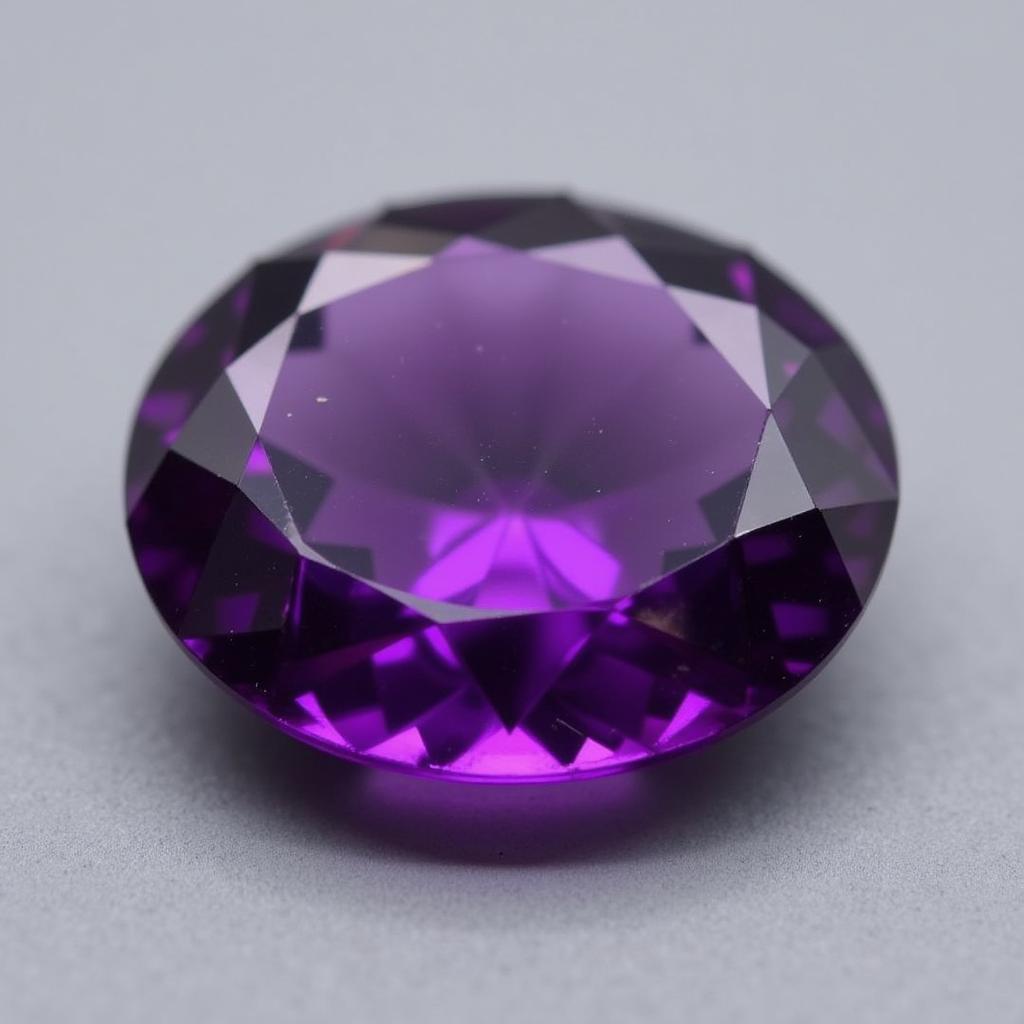Amethyst, a captivating gemstone, has mesmerized people for centuries with its stunning violet hues. But what color is the amethyst, exactly? The answer is more nuanced than a simple “purple.” Let’s delve into the fascinating world of amethyst color, exploring its variations, origins, and the factors that influence its mesmerizing shades.
Decoding the Amethyst Color Palette
Amethyst’s color ranges from a pale lilac, almost reminiscent of lavender, to a deep, rich purple that evokes royalty. The most prized amethysts exhibit a vibrant, medium-dark purple with reddish or bluish undertones, sometimes referred to as “Siberian amethyst.” This captivating hue is often described as having a “velvety” appearance, adding to its allure. The intensity of the color plays a crucial role in determining an amethyst’s value. Generally, deeper and more saturated colors are considered more desirable. However, excessively dark amethysts can appear almost black, diminishing their brilliance.
 Deep Purple Amethyst Gemstone Close Up
Deep Purple Amethyst Gemstone Close Up
The specific color of an amethyst is primarily determined by the presence of iron and other trace elements within its crystal structure. Natural irradiation from surrounding rocks also contributes to the gem’s color development. While most amethysts display variations of purple, some rare specimens can exhibit green or even yellow hues, known as prasiolite and citrine, respectively. These color variations occur due to different heat treatments or variations in the mineral composition. Understanding these nuances can help you appreciate the diversity and beauty of this enchanting gemstone. what color are amethyst offers more details on the color variations.
What Influences the Color of Amethyst?
Several factors contribute to the final color of an amethyst. As mentioned, the concentration of iron is a primary determinant. Higher iron content typically results in deeper purple shades. The type of irradiation the amethyst is exposed to during its formation also plays a significant role. Gamma rays from radioactive elements in the surrounding rocks can intensify the purple hue. Furthermore, the temperature at which the amethyst forms can influence its color. Higher temperatures can lead to lighter shades, while lower temperatures can produce deeper, richer purples.
What is the most common amethyst color?
The most common amethyst color is a medium purple, often with reddish or bluish undertones.
What causes the variations in amethyst color?
Variations in amethyst color are caused by differences in iron content, irradiation exposure, and formation temperature.
Amethyst: Beyond the Purple
While purple is the defining color of amethyst, it’s important to note that what is the color amethyst can encompass a surprising range. Some amethysts exhibit color zoning, where different parts of the crystal display varying shades of purple. This phenomenon adds a unique depth and character to the gemstone. In rare cases, amethysts can exhibit other colors due to different treatments. Green amethyst, known as prasiolite, is created by heating amethyst to high temperatures. Yellow amethyst, or citrine, can also be produced through heat treatment. These variations expand the possibilities for jewelry and decorative applications, making amethyst a truly versatile gemstone. For those interested in the birthstone connection, what color stone is february offers insightful information.
The Allure of Amethyst in Design
Amethyst’s captivating color has made it a popular choice in jewelry and interior design for centuries. From elegant necklaces and rings to decorative objects and home accents, amethyst adds a touch of elegance and mystique to any setting. Its versatility allows it to complement various design styles, from classic to contemporary. Whether used as a statement piece or a subtle accent, amethyst’s beauty is undeniable. You might be interested in exploring more about what color is an amethyst stone.
John Peterson, a renowned gemologist, states, “Amethyst’s captivating color has made it a timeless favorite. Its diverse shades and unique characteristics make it a truly special gemstone.”
Conclusion: Embracing the Spectrum of Amethyst
From its delicate lilac whispers to its deep royal purple declarations, amethyst offers a captivating range of colors. Understanding the factors that influence its hues allows us to appreciate the complexity and beauty of this enchanting gemstone. Whether you’re drawn to its calming lavender tones or its vibrant violet brilliance, amethyst is a gemstone that continues to fascinate and inspire. So, the next time you admire an amethyst, take a moment to appreciate the intricate interplay of nature’s elements that created its unique and mesmerizing color. what is the color of amethyst stone provides a comprehensive overview of this topic.
FAQ
- What is the rarest color of amethyst? Deep Siberian amethyst, a rich, vibrant purple, is considered the rarest and most valuable.
- Can amethyst change color? Prolonged exposure to sunlight can fade the color of amethyst over time.
- Is green amethyst natural? Naturally occurring green amethyst is extremely rare. Most green amethyst on the market is created by heating purple amethyst.
- What is the meaning of amethyst? Amethyst is often associated with spirituality, clarity, and sobriety.
- How can I tell if an amethyst is real? Genuine amethyst will exhibit color zoning and may have inclusions.
For any assistance, contact us at Phone Number: 0373298888, Email: [email protected] or visit us at 86 Cau Giay, Hanoi. We have a 24/7 customer support team.
